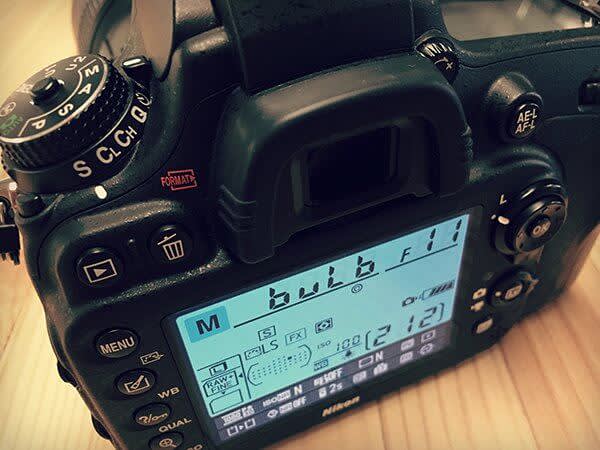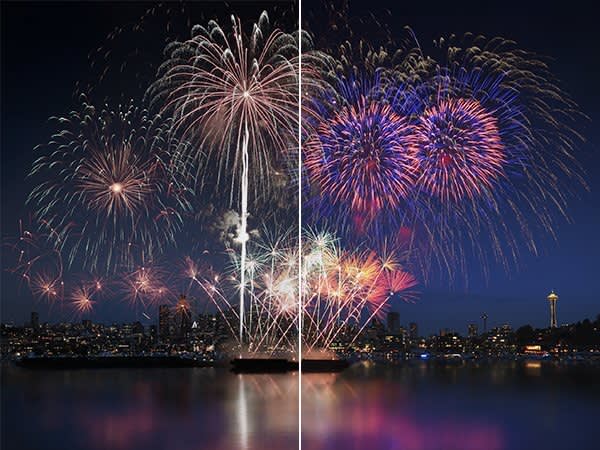America, woohoo! It’s time to gather around your local fairgrounds for a face-melting spectacle of booming independence (and thousands of dollars of advanced pyrotechnics)! Listen to the pops, smell the hotdogs, and get out that camera, ’cause this is gonna be quite the show. Remember to open up the Editor if you’re ready to edit your pics!

But wait! is your camera ready? Do you really know if you’re actually prepared to take pictures of fireworks. We’ll get you prepared with our expert camera settings, composition notes, and photo editing tricks.
White Balance
A Tungsten (around 3000 K) white balance is best. You’re shooting at night, or close to it, and since fireworks are explosions, your colors are going to be on the warm side. Tungsten will make sure that these warm colors are being, well, balanced. If you think the fireworks look too warm in your photos, dial it down a bit and try again. Consider an automatic setting your last resort.
Tip: If you don’t get it quite right, you can always adjust the color temperature in PicMonkey.

Exposure
These exposures are going to be longer than your typical shot, so use a tripod. Set your camera to manual exposure and your shutter speed to BULB, beyond your slowest shutter speed. This will let you hold open the shutter as long as you want to capture the firework from launch to full bloom.
Start with your F-stop at 11. This is a safe number, it gives you room on both sides if you need to adjust exposure later. If, after a couple snaps, you think your fireworks are too dim, open up your aperture (lower number). If they’re too bright, close the aperture (higher number).
Your camera’s default ISO, which is probably 100 or 200, is perfect. Auto ISO won’t work. If you open your aperture and still find that your fireworks are too dim, increase your ISO. But consider that your last resort, as increasing ISO can make your pictures grainy and noisy. If you dramatically adjusted your ISO, in-camera noise reduction could improve your image quality, but it’ll lock you out of your camera for twice as long as your exposure duration.
Focus
Autofocus struggles with focusing on the nothingness of a night sky, so you’ll get to manually focus your lens. Now, you might be tempted to twist your focus all the way to infinity, until it stops twisting (see the image on the left). But you’ll get a sharper focus if you actually stop just before all the way (like the image on the right).

Note the position of the notch in relation to the infinity symbol. The left image is what twisting the focus all the way out looks like. The right image is the proper infinity focus. You want to be the image on the right.
Shooting and Composition
For sure do not shoot into the wind. Fireworks make smoke, and depending on your angle, that smoke could look silky and surreal with your long exposures. But if it’s in front of your fireworks, the whole thing will be blurrier than a vintage set of broken binoculars.
Great fireworks pictures need more than just fireworks. Anyone can take a picture of some sparkles against nothing but a black sky, but you can do better.
With your tripod, find an interesting way to frame your fireworks. Water makes for some nice looking reflective greatness, as we covered in our landscape photography tips. For you landlubbers, there are still some awesome composition strategies. The long exposures will bring a beautiful ambient light to the surrounding scenery. Bridges, landscapes, or the audience itself will complement the show.

Tip: Manually pressing the shutter button almost certainly results in some camera shake during the exposure. To be absolutely certain that you’re avoiding any shakiness during your long exposures, use a remote cable release to control your shutter.
Editing

Nature doesn’t care about your perfect settings and your expert tips, and sometimes we all just hafta accept that. Fortunately, PicMonkey defies nature. If something didn’t work out in the moment, you can probably fix it in PicMonkey.
For fireworks, we recommend the vibrance tool Burst. From the Effects tab, scroll down to the Paintbox effects group. Burst is the last one in the group. Think of Burst like smart saturation. It identifies the colors that are less saturated than others, analyzes those colors, and then enhances the vibrance of your image.
Use our Burn effect to darken your night sky without affecting your fireworks. (To learn more about Burn, watch our Dodge & Burn tutorial.) Burn darkens what’s already dark, so it’s perfect for getting a smooth, black sky without changing the exposure of your fireworks. Just remember to pick Dark instead of Light or Mid.
